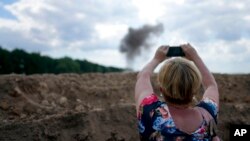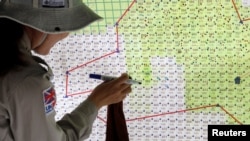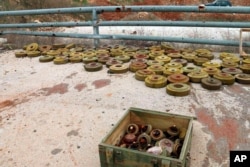U.S. aid helped Ukraine clear and destroy more than 530 explosive remnants from its land last year, but Ukraine still has massive swaths of territory contaminated with land mines, unexploded ordnance and improvised explosive devices as a result of Russia's invasion of the country, according to a State Department report.
In an annual report released Tuesday, the U.S. State Department documented its efforts to help more than 60 countries destroy explosive hazards and other conventional weapons, with Ukraine receiving the most assistance in fiscal year 2022 — more than $91 million.
Ukraine’s government estimates that 160,000 square kilometers of its territory contains explosive hazards — a stretch of land nearly twice the size of Austria — and says about 10% of the country’s agricultural land is now too dangerous to farm.
“Russia’s brutal invasion is thus further worsening the global food crisis,” according to the report, “To Walk the Earth in Safety,” co-written with the Center for International Stabilization and Recovery at James Madison University in Virginia.
Before Russia’s invasion of Ukraine in February 2022, Ukraine was one of the world’s largest producers of wheat and other grains.
U.S. assistance to Ukraine in the fiscal year ending in September 2022 provided training and equipment to demining teams across Ukraine, as well as funded educational programs about the dangers of hidden explosives, reaching 18 million Ukrainians.
“Ukraine is now one of the most contaminated countries in the world and it gets worse every day,” said Heather Holsinger, communications and publications manager at the Center for International Stabilization and Recovery.
Holsinger told VOA that the explosive hazards in Ukraine are scattered in both rural and urban areas and will likely take decades to clear once the conflict ends.
Worldwide, the United States spent $376 million to help destroy explosive devices and other conventional weapons in fiscal year 2022. After Ukraine, the U.S. spent the most money in Laos ($45.0 million), Iraq ($40.3 million), Colombia ($24.5 million) and Vietnam ($20.3 million).
Asia
Thousands of communities across East Asia and the Pacific continue to face dangers from landmines and explosive remnants of war dating back to World War II, the Indochina Wars and the Vietnam War, according to the report.
Holsinger told VOA that Laos — the most heavily bombed country per capita in the world — still has contamination in 14 of 17 provinces, 50 years after the U.S. bombing there ended and despite organized clearance efforts since the early 1990s.
“It is much faster and cheaper to deploy a landmine or cluster munition than it is to clear it,” she said.
Since 1993, the United States has provided more than $750 million to Laos, Vietnam, and Cambodia to destroy conventional weapons.
Throughout Asia, economic development along with growing populations that have expanded into previously uninhabited areas have continued to expose civilians to explosive remnants of war.
Climate change is also increasing the danger of unexploded ordinance. In Southeast Asia, heavier rainy seasons have resulted in more landslides and floods, which can expose long buried explosives, while in the Pacific, rising sea levels have forced residents to move into previously uninhabited areas contaminated by explosive hazards, according to the report.
In South and Central Asia, the United States focused the majority of its funding last year on Afghanistan — $15.2 million.
Funding for demining programs continued in the country despite the August 2021 takeover by the Taliban and were delivered through nongovernmental organizations, the report said.
Afghanistan, which has experienced decades of conflict, has received more than $573 million in such U.S. assistance since 1993, the most of any country during that time period except for Iraq.
Western Hemisphere
In the Americas, Colombia is the country most affected by landmines, according to the State Department report.
Colombia’s Office of the High Commissioner for Peace recorded 12,322 victims of explosive ordnance from 1990 through February 2023.
Since 2016, demining operations in Colombia have expanded into previously inaccessible locations, due to the government’s peace accord with the Revolutionary Armed Forces of Colombia, according to the State Department. U.S. government assistance helped Colombia to clear nearly 200,000 square meters of land in 2022.
In other parts of the hemisphere, U.S. aid funded the security and management of munitions stockpiles in Ecuador, El Salvador, Guatemala, Honduras, Peru and the Caribbean region.
Africa
In sub-Saharan Africa, Angola received the most U.S. assistance to destroy conventional weapons ($8.6 million), followed by Somalia ($4.0 million) and Zimbabwe ($3.3 million).
“Angola made great strides in 2022 to recover from over 40 years of conflict that ended in 2002,” according to the report. U.S.-funded demining operations in the country last year returned more than 2 million square meters of land to local communities.
Part of the funding in both Angola and Zimbabwe was used to protect animals and facilitate wildlife conservation, including mine clearing in Angola’s Okavango watershed and Zimbabwe’s Gonarezhou National Park.
The Sengwe Wildlife Corridor, which runs between Gonarezhou National Park and the Kruger National Park in South Africa is one of the most densely laid minefields in the world, with an estimated 5,500 mines per square kilometer, according to the report. The mines were placed during the Zimbabwe Liberation War from 1964 to 1979 and continue to kill and injure wildlife as well as block economic development in the region.
Middle East
Of the six countries with the highest number of civilian casualties from explosive remnants of war in 2021, three are in the Middle East — Syria, Yemen, and Iraq — according to the 2022 Landmine and Cluster Munition Monitor.
Syria had the highest number of such casualties that year with 1,227.
In Iraq, the State Department said the United States and other international donors have made significant progress since 2015 in clearing sophisticated improvised explosive devices left by Islamic State.
It said that in summer 2022, farmers across areas of Iraq liberated from Islamic State were able to safely harvest crops for the first time in many years.
Holsinger said throughout the world, mine clearing activities have been improving due to advancements in surveying techniques, including the use of drones and remote sensing technologies to identify potential hazards.
Worldwide, the United States has provided more than $4.6 billion to over 120 countries to support conventional weapons destruction from 1993 through September 2022.
The United States is one of only a handful of countries — which also includes Russia and China — that have not signed the 1997 Mine Ban Treaty, prohibiting the use of antipersonnel mines.
In November, the International Campaign to Ban Land Mines reported that Russia and Myanmar were the only two governments to have used such mines last year.









